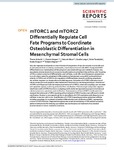mTORC1 and mTORC2 Differentially Regulate Cell Fate Programs to Coordinate Osteoblastic Differentiation in Mesenchymal Stromal Cells
Schaub, Theres
Gürgen, Dennis
Maus, Deborah
Lange, Claudia
Tarabykin, Victor
Dragun, Duska
Hegner, Björn
Vascular regeneration depends on intact function of progenitors of vascular smooth muscle cells such as pericytes and their circulating counterparts, mesenchymal stromal cells (MSC). Deregulated MSC differentiation and maladaptive cell fate programs associated with age and metabolic diseases may exacerbate arteriosclerosis due to excessive transformation to osteoblast-like calcifying cells. Targeting mTOR, a central controller of differentiation and cell fates, could offer novel therapeutic perspectives. In a cell culture model for osteoblastic differentiation of pluripotent human MSC we found distinct roles for mTORC1 and mTORC2 in the regulation of differentiation towards calcifying osteoblasts via cell fate programs in a temporally-controlled sequence. Activation of mTORC1 with induction of cellular senescence and apoptosis were hallmarks of transition to a calcifying phenotype. Inhibition of mTORC1 with Rapamycin elicited reciprocal activation of mTORC2, enhanced autophagy and recruited anti-apoptotic signals, conferring protection from calcification. Pharmacologic and genetic negative interference with mTORC2 function or autophagy both abolished regenerative programs but induced cellular senescence, apoptosis, and calcification. Overexpression of the mTORC2 constituent rictor revealed that enhanced mTORC2 signaling without altered mTORC1 function was sufficient to inhibit calcification. Studies in mice reproduced the in vitro effects of mTOR modulation with Rapamycin on cell fates in vascular cells in vivo. Amplification of mTORC2 signaling promotes protective cell fates including autophagy to counteract osteoblast differentiation and calcification of MSC, representing a novel mTORC2 function. Regenerative approaches aimed at modulating mTOR network activation patterns hold promise for delaying age-related vascular diseases and treatment of accelerated arteriosclerosis in chronic metabolic conditions.
Dateien zu dieser Publikation

